Joy E. Rancatore's Blog, page 8
May 8, 2019
Embrace Your Style
You’ve got a style unique to you. A fashion style. A work style. A social style. So many types of styles!
My question for you is: do you know what your style is? And, if you do, have you learned to embrace it?
These are some questions I’ve been answering for myself over the past few weeks. With the answer to my writing style and the acceptance of it have come freedom and clarity I didn’t expect. Maybe you’ll discover the same!
How did I find my style?
Let me share what started all of this inner reflection. Last week I read a great book—Above the Waterfall by Ron Rash.
(Sidenote: you can read my review on Goodreads, give my author profile a follow while you’re there and see why I think Goodreads is the best site on the internet in last week’s post.)
As I was saying, it really is a great book and one that falls in a similar genre with my upcoming novel, Any Good Thing. Southern fiction tends to have a certain cadence and specific character traits and themes. Ron Rash does an outstanding job with all of these. His prose is lyrical. His descriptions paint the setting around you as you read, and his dialogue speaks from the pages of his books. He is an outstanding storyteller.
On the heels of those thoughts came this inner turmoil: “I am nowhere near this caliber of writing. My prose isn’t this beautiful. Maybe my dialogue isn’t this good. What if my characters aren’t deep enough? He leaves so much open-ended with their pasts and futures, but does it well. I don’t know if I did it right. I may not be a good storyteller after all. What on earth am I doing thinking I can be an author?”
You see where I’m going with this thought process, right?
Fear. Self-doubt. Depths of despair.
But then my little brain did something it may not have done a few years ago. It started whispering other thoughts, barely audible at first. I finished the book and started another one. This one also southern fiction, but by a different author—Tim Gautreaux. He writes beautifully as well. His prose may not lilt quite as much as Ron Rash’s does, but the comparisons and the pictures he paints are so common, so every-day, that they are brilliant and beautiful in their own way. I’m currently reading his novel The Clearing. Last year, I read a collection of his short stories, Signals. I love his slice-of-life stories and his matter-of-fact narrative. He reminds me of Mark Twain in many ways.
These two authors couldn’t be more different in style, but I love them both equally because at the heart of their books are stories, worthy stories. They are stories of people and places—all commonplace and ordinary—told in extraordinary ways. Two very different ways, I might add.
So, as I broke through the first few chapters of this second of two similar novels, that quiet thought grew louder until I finally heard, understood and then embraced it.
My writing style is unique to me. That style does not make my book worthy or “good.” What makes it those things is the story itself. My style is what makes the story mine. My style is what I own and do not share with another soul. My style is what will turn some readers off. It’s also what others will love so much it will cause them to return for the next book and the next and all the ones tucked safely away in my writer heart, waiting patiently for their turns to beat out into the literary world.
When I pen my stories, I strive to write using all the senses. I love lyrical prose for descriptions and lovely words that don’t get as much use as they deserve, but I don’t use as many big words as many literary fiction writers do. My writing is somewhere between an old-school approach and contemporary. I don’t know that I fit in some of the boxes out there. I certainly couldn’t squeeze myself into one genre and would be miserable if I tried.
I may not be able to concisely or completely describe my writing style right now, but I now know I have one and I’m embracing it. Thinking about a future of polishing and developing that style excites me, and I’m no longer in the depths of despair!
Embracing a style is one of those little mountaintop experiences that creatives cling to when they appear because the valleys are deep and the climb is steep, but these peaks keep us moving forward.
What is your style, friend?
Maybe you’re not a writer. So, what is your reading style? Do you prefer drawn-out, poetic descriptions … what some call purple prose? Would you rather read straightforward, simply told stories? Do you want a story to come to you through the thoughts of one character? Would you rather multiple narrators or one master storyteller spinning the yarn for you?
What about in life? Here’s one every person needs to answer—what is your work style? Sure, some jobs are pretty static in what they require; however, the way you approach your work requires your own style. Maybe you’ve been discontent in your cubicle for so long, but you don’t know why. Perhaps you’re trying to copy everyone else’s style or the style your company has tucked you into. How about you give your own methods and approach a shot this week? See what happens. You might just be surprised!
Here are two more style revelations, just for fun!
I’ll give you two more personal style examples I’ve discovered recently. The first, I’m still trying to figure out—my fashion style. I’ve thought for a long time that I don’t have one, but as I was folding clothes the other day I pondered it. Sure, I’ve got a mixed wardrobe because I’ve been blessed with many hand-me-down gifts and rarely shop for myself. When I do shop, I hit the sale racks; so I limit my choices off the bat. As I really thought about it, though, I do have a style in there somewhere. If I had to name it at the moment, I’d say practical and comfortable; but I’m going to keep digging because I think I’ve got something hidden in a tucked away fashionable corner of my brain. I will give you one slightly better description through the name of one of my favorite shows—Grey’s Anatomy. Take that as you will. It makes sense to me!
On to the second style. This one ties back in to my writing. You know how, when you’re single, all your friends ask what your “type” is? I could never answer that. I dated blonds, brunettes; some tall, some short, mostly average height. They all had varying interests and profession choices. But, as I reflected the other day on the characters I tend to write, I realized I most certainly do have a “type.”
Bearded, scarred and a little rough around the edges.
It turns out I married my “type” and didn’t even realize it!

What’s your style? Do you have all the styles in your life figured out or are you still trying to find them? Have you embraced the ones you do know? What style are you struggling with today?
I’d love to hear all about your reading styles. Who are some of your favorite authors? What is it about their writing that really grabs you?
Writers, have you figured out your style yet? Did discovering that and embracing it teach you anything unexpected? How did you figure it out?
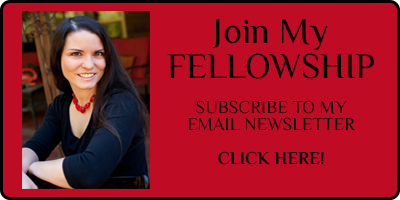
FollowFollowFollowFollowFollow
The post Embrace Your Style appeared first on Joy E. Rancatore.
May 1, 2019
How to Make the Most of Goodreads
Readers and authors have come together since 2007 thanks to the largest online book club, Goodreads. Book recommendations based on readers’ preferences or from friends encourage continued reading and exploration of books they otherwise would not have discovered. Authors have come into the lives of their readers, thanks to Q&As, giveaways and the accessibility of their profiles.
Since 2010, I’ve been part of this community, and it has always been my favorite place online. Last fall, thanks to the tremendous opportunity of having a story published in The Crux Anthology, I became a Goodreads Author. I’m not ashamed to admit, I cried. For years I eyed that title with a little jealousy and a whole lot of longing.
What surprised me was how easy it was to set up my profile and immediately connect with readers. And, that’s part of what I want to share with you here. Now, while this is geared primarily toward my writer friends, I hope my reader friends will keep reading. You will learn a few behind-the-scenes details for the author’s side of things; plus, you may just discover new tricks to interacting with some of your favorite authors … even the big-name ones!
Set up an author profile.
I agree that this sounds simple, perhaps too simple. Unfortunately, you have no idea how many times I’ve searched for books or authors only to discover that, while their book may appear on Goodreads, the author is MIA. As is information about the book. With billions of books to choose from, why on earth would a reader pick a book if they can’t even tell what it’s about or see the cover? (Seriously, as of this post, Goodreads alone showcases 2.5 BILLION books … yes, with a B.)
In a recent post, I urged my fellow Indie Authors to be professional, but the same message goes for all authors. More often, publishers are leaving most of the marketing and even simple setups (such as Goodreads profiles) totally up to their authors. This is one easy way to present yourself as a true professional.
Goodreads makes this incredibly simple for us. Once you have set up your book information, including the ISBN and all that good stuff, you can easily claim your book and set in motion the process of becoming a Goodreads Author. It takes no time at all! When I did it, I really did it on a bit of a whim. For whatever reason, I didn’t think they’d really consider me a “real” author yet. After all, my name was one of sixteen on the anthology. But, sure enough, instead of the too-bad-so-sad-try-another-time response I expected; I pretty quickly got a “Welcome to the Goodreads Authors program” one!
Set it up all the way!
Don’t stop with claiming your books as your own. Make sure your author profile includes your photo, all of your books, your biography and links to all the important places. You can even link your blog to your profile with minimal effort. I remember it being only one click because I figured I must have missed something; it couldn’t be that simple. Imagine my surprise on the next blog day. There was that day’s post right on my profile!
This is the part that, I’ll be honest, I don’t understand. And, yes, I’m about to sound snarky. I’ve seen too many authors miss out on so much good because they fail to do these things. Can we be totally honest? Starting a business of any kind is incredibly expensive, time-consuming and frustrating, right? Becoming an author is starting a business, my friend. It’s hard; we put out way more than we bring in (and may bring in for quite a while). Goodreads is a well-established program built for READERS … you know, our target audience … and we can put up a profile with links to EVERYTHING with all the details about all of our books … for FREE!! In case you missed that last word, it was FREE, as in the ONLY thing you don’t have to pay an arm and a leg to set up properly. And, it’s one of the very few things—perhaps the only thing—that immediately gets in front of the attention of readers.
And, we’re not talking a few readers. As of this posting, Goodreads boasts 85 MILLION members! Do I have your attention yet?
Now, before you fret that you can’t figure out how to update your profile or set everything up, here’s a screenshot from the welcome email I received from them. Those links walk you through, step by step.
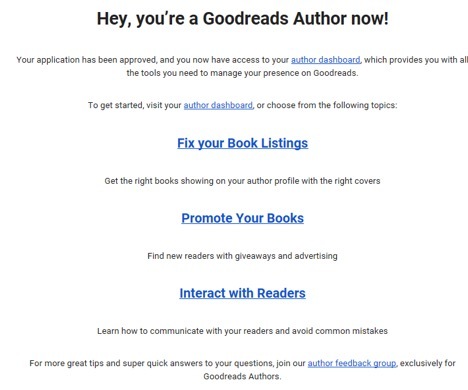
Don’t set it and forget it.
Like all social media, you must interact. I’ve got some specific suggestions here, but first I want to go over who all is going to see your new-and-improved profile. We’ve covered our wonderful readers, but there are also librarians, bookstore owners, agents, publishers, book bloggers, book reviewers and other writers on there. Those first several friends I mentioned could alter the course of your literary future. That last group, fellow writers, can be some of your greatest allies.
Share your URL.
The internet doesn’t magically make you internationally famous, of course; at least not for good, solid writers who just want to reach great readers with worthy stories. You need to let people know you’re there. Share your profile with followers on other social media outlets, in your email newsletter and on your website.
Become part of the community.
Follow other authors, friend fellow readers, post reviews, like others’ reviews or posts, recommend books, participate in the annual Reading Challenge and cheer on other participants. Join groups that interest you and be an active part of them.
As a Goodreads Author, you can also answer questions on your profile. This is something I hope to do more soon. This makes you approachable and gives readers more insight into who you are, not just as a writer, but as a person.
Readers, you really can ask many of your favorite authors questions … and get them answered! Plus, you get to see what they’re reading. Yes, authors read books, and they even swoon over their favorite authors! It’s really quite funny.
Get help from others on Goodreads.
Through those groups, you can find help with anything from book titles and covers to beta readers to genre-specific concerns. You may also get more reviews on Goodreads than you do on sites such as Amazon, and we all know reviews are better than gold for the emerging author.
Do market research.
When I wrote my business plan a few months ago and found myself stumped by all the market research and target audience questions I needed to answer, I went to Goodreads. I searched for authors who write similar books to mine and found some I hadn’t considered. Then, I started reading the reviews those books got and began to fill in the outline of who my ideal readers are.
As a little sidebar, reading those reviews taught me much more, too. I found that what one reader may love about a book will be the same thing that other readers hate. I also realized just how many thoughtless, unhelpful book reviews there can be. That spurred me on to write my series on KINND Book Reviews, to revitalize the way I write my own reviews and to develop a template for how to write them that I could share with other readers.
Do even more targeted advertising.
Through your author dashboard, you can manage giveaways and set up advertising that you can be confident will go directly to your ideal readers. Now, I want to point out two things at this point: 1. You do realize we passed the 1200-word mark in this post before we got to anything that requires money out of your pocket, right? 2. I have not tried this type of advertising yet, so I cannot give you any pros/cons. In my consideration, though, this seems like a great option. I’ll be sure to update this once I do, though. If you’ve used these methods, share your wisdom in the comments!
I’d love to hear from all of you who are on Goodreads as readers, authors or both! What do you like about the community there? Did you learn anything in this post you didn’t know? Do you have any extra tips to share with us?
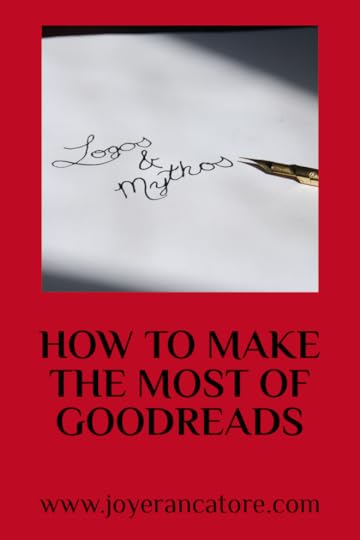
Authors, do you have a Goodreads Author profile? Share your link in the comments below!
Readers, have you ever interacted with favorite authors on Goodreads? Was it a giveaway or Q&A or something else?
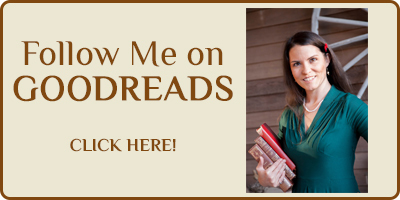
If you’re not on Goodreads yet, today’s a great day to sign up! Give me a follow while you’re there and ask me a question. I’d love to chat!

FollowFollowFollowFollowFollow
The post How to Make the Most of Goodreads appeared first on Joy E. Rancatore.
April 24, 2019
Sacrificed Purpose
This story continues a series of short fiction exploring some of the Faerie Shepherds and Shepherdesses within my fantasy world. Read below the story for further explanation and head over to the Tales of the Faerie Shepherds if you’d like to read more!
Twas the morn I knew I would die. I might’ve thought I’d be afeared, sorrowed, lost. None of those fit. Instead I was filled wi’ calm. Twas like the calm afore a storm; and I spose it was. I ken afore the night fell once maer, I’d be gone from this airth. Nae maer joy or pain; abundance or want. Nae maer.
I’d seen how it would happen. I ken at whose hand I’d fall. The visions rose once maer in small flashes. The calm stood fast. I thought of how I loved her. How any sacrifice I made were wee compared to hers. If my release from the bounds of this airth could grant her some relief, twere worth it an hundredfold. I was ready; and so, I opened my mind and heart and soul to the calm round and within. I let it swallow me whole, for I had nae reason not to succumb to its bliss.
Until …
A new vision rose from the stillness. The images swallowed all peace and purpose; for another must be crushed for all realms and peoples.
Not this other.
In the airth’s shift, my calm erupted. Twas the day of my purposeless death.
“Sacrificed Purpose” Copyright © 2019 by Joy E. Rancatore. All Rights Reserved.

What do you think about this world of mine that I’m building? If you enjoyed this story, please head over to my site to read the entire Tales of the Faerie Shepherds series .
This month’s story flowed from the inspiration of a delightful monthly online writing prompt, #BlogBattle. As you will read on their site, “Blog Battle is a monthly writing prompt meant to inspire writers and entertain readers.” To read several outstanding stories inspired by April’s prompt, “Shift,” head on over to the BlogBattlers site!
You may just find a new favorite author to follow!
For more detailed weekly updates on my writing process behind this short story as well as my other works, please subscribe to my newsletter!

The post Sacrificed Purpose appeared first on Joy E. Rancatore.
April 17, 2019
What Do You Love About April?
A Births B
by Joy E. Rancatore
Birds chirp.
Butterflies flit.
Blooms open.
Birthdays bring candles,
and books find the spotlight.
April begets Beauty.
April happens to be my birth month, which is fantastic because it is an extremely LITERARY month. Recently I did a little digging to find out what other authors share my birth month, and I’m pretty excited about my discoveries!
I’m in impressive company with these literary giants, just to name a few:
April 2, 1805: Hans Christian Anderson, “The Little Mermaid” & “The Princess and the Pea”
April 3, 1783: Washington Irving, “The Legend of Sleepy Hollow”and “Rip Van Winkle”
April 4, 1928: Maya Angelou, I Know Why the Caged Bird Sings
April 7, 1770: William Wordsworth, “The Rime of the Ancient Mariner”
April 8, 1955: Barbara Kingsolver, The Poisonwood Bible
April 12, 1916: Beverly Cleary, The Mouse and the Motorcycle and the Ramona series
April 13, 1902: Marguerite Henry, Misty of Chincoteague
April 13, 1909: Eudora Welty, A Curtain of Green and The Robber Bridegroom
April 21, 1816: Charlotte Brontë, Jane Eyre
April 23 (or thereabouts), 1564: William Shakespeare, Hamlet, MacBeth and Romeo & Juliet
April 24, 1940: Sue Grafton, A is for Alibi through Y is for Yesterday
April 27, 1898: Ludwig Bemelmans, Madeline series
April 28, 1926: Harper Lee, To Kill a Mockingbird
April 28, 1948: Terry Pratchett, Discworld
As if that lineup weren’t enough to inspire and excite me, April holds a few more literary distinctions.
National Library Week : You all know how much I love my library .
School Library Month
National Poetry Month : Last Year, I did a month-long tribute to poetry beginning with this post .
Poem in Your Pocket Day : This happens to fall TODAY, April 18, 2019. What is your favorite poem? And, are you carrying a #pocketpoem today?


In honor of this month, I hope you enjoy the three poems I’m sharing with you today. My newsletter subscribers received another one in their inboxes today. If you’d like to join my Fellowship for other extras and exclusives, click on the button below to subscribe and then reply to my welcome email to let me know you’d like to read my extra poem, “My Favorite Place.”
Tell me how you’re celebrating this lovely literary month. Are you reading a new book or revisiting an old favorite? Do any of your favorite authors have April birthdays? Did you do something special with your local library or child’s school library? Have you participated in a poetry reading or read a favorite poem?

FollowFollowFollowFollowFollow
The post What Do You Love About April? appeared first on Joy E. Rancatore.
April 10, 2019
Libraries Inspire Books
Libraries inspire books because they inspire writers.
Since this is National Library Week, I wanted to share a few library memories from me and a couple of my author friends.
When I was growing up, my family moved often. After a church, the local library was always the next spot we would scope out. I grew up devouring every horse book each library contained. I went through series like Nancy Drew and The Babysitter’s Club. Whenever I reached the front desk, the workers had a challenge before them with the stack of books I hoisted in front of them.
During the early years of double digits, I graduated myself to the adult section and a whole new world of possibilities. I fell in love with Mary Higgins Clark, Louis L’Amour and Agatha Christie. My first job was in that library. The Elizabeth Jones Library in Grenada, Miss., gave me my first paycheck and taught me the behind-the-scenes of one of the most magical buildings in any community.
When I had my first child, I silently battled postpartum depression for months. The Wake Forest Community Library started their weekly activities for little ones at six months old, so off I went with my kiddo as soon as she was old enough. At our first event, I met my first two mom friends and found the healing balm I had so desperately needed thanks to them and that weekly outing. Two years later, we were still going, and I brought my new little one along from day one in his little sling.
Less than a year later, we made the move to Louisiana and quickly discovered the St. Tammany Parish Libraries. My first friend here was our precious children’s librarian, Mrs. Mim. While she has since retired, we still have an incredible children’s librarian—shoutout to Mrs. Jen!—who works hard to offer tons of great programs for families.
A few months ago, my husband and I were waiting for a program to begin when I realized something. My kids have grown up in this library. When they were younger, we attended weekly story times and most of the family night story times as well. Now that they’re older, they participate in a book club. During the summer, you can bet we’re at the library two or three times a week for all the special summer reading opportunities. Actually, more than that! Our library system has an outstanding Battle of the Books program where teams from each branch battle it out to see who can answer the most questions about their assigned books.
My kids have had countless opportunities, thanks to our libraries. They’ve made friends, learned how to be researchers and lifelong learners, participated in STEM classes, met real-life authors and illustrators (and even interviewed one for a podcast!) and been part of our literary community. The staff of our library love my kids, and the feeling is definitely mutual!
Libraries encourage kids to explore the endless adventures books offer. Because of them, kids all over find their passions for outer space, horse training, history or writing.
Look around at your library’s kids programs, and you may just see a future author receiving his or her first inspirations from a book read aloud or from the words of an author who’s sharing how they came to have their name on a bookshelf.
Every story I write has different inspirations, but they all have a common one at the center—libraries. Thanks to the magic ticket of library cards I’ve held through the years, I have entered countless portals into the endless realms of literature. Now I get to add to those collections and help the inspiration continue for many more generations.
More Library Memories from Fellow Authors
“I loved the old card catalogues—the long, narrow drawers were like treasure chests full of secrets. And of course I remember my first very own library card—my ticket to adventure!”
Julie Mayerson Brown
author of Long Dance Home and A Clearwater Christmas

“This beautiful building was the main building of the public library when I was little.
I remember sitting with other kids to hear and see books read by one of the librarians. It was through the library that I began public storytelling. In a world before computers, the library was where I researched all sorts of things I was curious about. And just a few days ago, mom and I walked down to the library to pick up some books I needed to read for a book club I’m in. The library today is larger, technologically advanced, and even has a coffee shop.
I’m glad this building has been preserved and continues to function as part of the now much larger Cleveland Bradley County Public Library.
We just left the ‘new’ (30+ years) library building where they now have my paperbacks and are readying them for circulation! Also stopped by the Lee University library, and they just got their copies today also.”
Paul Andrew Skidmore, author of Kindling and The Darkness Rolled Over Her
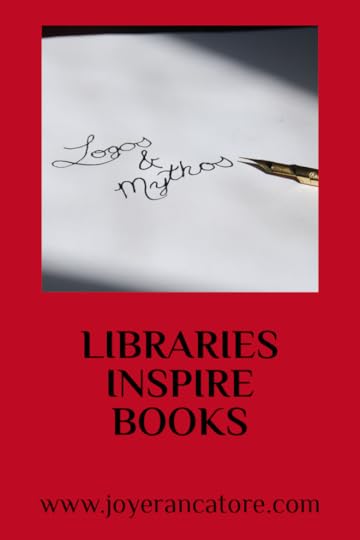
Your turn!! Please share your best library memories with us. They could be from your childhood, your kids’ childhood or today!
What do you think is the best thing about our libraries? Have you found inspiration in a library for your own career or hobbies? What kind of activities and events do you attend at your library?
Have you ever attended an author event or signing at your library? Who was the author? What did you enjoy most about their presentation?

FollowFollowFollowFollowFollow
The post Libraries Inspire Books appeared first on Joy E. Rancatore.
March 27, 2019
What’s in a Name: The Birth of a Book Title
Each time I was pregnant, the best day was when we found out if we were having a boy or a girl. Why? Because then I got to call the tiny human growing within me by his or her name.
Names are powerful and important. They declare who someone is, set them apart, make them known. A book’s title does something similar. It makes the story real, alive, tangible.
I love naming characters, pets, vehicles—what, you don’t?—and most of my writing (short stories, poems, etc.) But, this novel has been stubborn. Okay, that’s not accurate. The novel’s been delightful, actually. It’s me. All me.
This book actually began with a title in place. It was a thing of beauty. It was perfection and brilliance … and meant for a fantasy novel, not southern fiction.
Everyone who read the title adored it. But, everyone who read it agreed that it wasn’t for this book.
My husband said it wasn’t right. All four of my critique partners said it wasn’t right. Other friends and family said it wasn’t right. And then I took it to a Twitter poll! Unanimous decision—it was made for fantasy, not literary fiction.
I was the stubborn one. I clamped down on that title like a toddler determined to keep sucking his pacifier all the way through college. Honestly, it’s a bit embarrassing.
Finally I admitted what I knew deep down—though I kicked and threw a bit of a tantrum in the process. Not my shining moment.
Over the course of this two-year process, this book has now had at least nine titles. It’s been title-palooza around here. I am happy to say, though, that Jack’s story finally has ONE title. And, it’s not going anywhere.
My newsletter subscribers—love you guys!—got to see it first this morning, and I cannot wait to share it with everyone on Monday night during my April Logos & Mythos Book Club LIVE on Facebook. If you can’t join me live (9 p.m. CST), you can catch the replay any time or see posts galore all over social media on Tuesday.
Until then, I’ve got a few reflections for you on the importance and requirements of a book title.
A title is like putting breath into a story and making it alive.
No longer do I have to call it “my book” or “the work-in-progress.” Now, it has a name all its own. It’s an identity, a moniker—for a living, breathing piece of literature.
In a few months, readers can say “I just read [A Great Title]; you should too!” [A Great Title] will adorn the spine of books on shelves across the country. [A Great Title] will forever and always be my first full-length book baby. It’s my debut novel.
And, I’m so proud to call it by its rightful name!
A title should fit the book’s genre, tone and theme—in other words, it needs to capture the book’s essence.
As I reveal more of the novel over the coming months, perhaps I’ll go a little deeper with what I’m about to share. Originally, a super famous book series featured prominently in my story. That book does happen to be fantasy. The title came from it and described a particular monster that I was using as a symbol of Jack’s inner demons.
So, at one point, the title made more sense. Unfortunately, copyright laws are tricky little buggers; and I didn’t want to take on the giant publishing company that holds the rights on these books.
I may have shed some tears. I definitely crossed sections out of the original draft with a tad more aggression than I had to. Of course, I still held on to the title. (Have I ever mentioned I’m more than a little stubborn?)
At the end of the day, though, that title no longer fit the story without the influence of those books.
It had never fit the genre.
And, as I began to work my way through revisions, adding layers and discovering the central themes and motivations throughout, it didn’t fit the tone or theme either.
I needed a few words that could join together to capture my story’s essence and convey it to all its potential readers.
A title eventually reveals itself and then adheres to the book like it was always meant to be.
Once I finally got over my stubborn insistence on a title that never truly belonged and embraced the one that did, I couldn’t imagine the cover in my mind with [Any Greater Title].
A title should make sense from a marketing standpoint.
Let’s face it. We live in an age of ad campaigns and catchy hashtags and abbreviations that might not lose attention spans like actual words seem to do.
Also, people like swag.
You know—mugs, T-shirts, bookmarks, jewelry, brown-paper packages tied up with string … with a cutesy quote stamped on them.
So, as much as we want to be serious wordsmiths and curators of the English language, authors also must be savvy marketers who ask themselves when picking a title, “Can I hashtag this?”
#[AnyGoodTitle] definitely works!
And, let’s just think back to junior high when everything suddenly took on double meanings and make sure our title’s abbreviation isn’t going to get us banned from a PG rating.
#AGT—that’ll play!
Of course, you’ve also got to run hashtags through social media so you know that #AGT is off limits. Thank you, America’s Got Talent.
That’s okay. I’m not a fan of letters unless they’re creating lovely words that can roll off my tongue!
A title should be as unique as possible.
You’ve also got to check for other books with the same title. With millions of books out there, chances of finding something that’s never been used before are pretty slim. However, you definitely want to avoid a name already attached to a well-known book, especially if it’s in the same genre.
I thought I’d found the next perfect title after I finally let go of my original one. Let me tell you, I was happy as a clam, tickled pink and any other cheesy phrase you can come up with. I blasted texts every which way.
“I’ve got the perfect title! Yay!”
And then, I typed it in to my web browser.
Curse you, whoever took over Tom Clancy’s empire and stole my perfect title!
I’m not bitter.
Now, I could have used the title. It’s not the same genre. Titles can’t typically be copyrighted. But, only a year would separate the publications. Plus, I would always know—it wasn’t mine first.
A title shouldn’t stop you from the purpose of your book—publication.
At the end of the day, some of us need a reminder that we cannot agonize over titles forever. A title choice may help you cross that line between aspiring author and published author.
Yes, the title is important. Yes, it sets the tone for your book. Along with the cover design, it is what draws a passerby in to pick up your book from among the countless other worthy choices.
However, if you listen to the people whose advice you trust, do your homework to determine what titles fit your genre and think through how to promote that name, you can move forward with confidence.
And that, my friend, is [A Great Thing] indeed!

Will you join me for my title reveal? I would love to hear your thoughts on it, too! If you’re already part of my Fellowship and got the first look in your inbox this morning, I’d love for you to reply to that email and let me know your reaction!
If you’re not signed up for my weekly newsletter yet, there’s no better time than now because I’ve got many more reveals coming soon. They’ll be rolling to my subscribers’ inboxes first, so join in the fun today!

FollowFollowFollowFollowFollow
The post appeared first on Joy E. Rancatore.
March 20, 2019
A Melding of the Realms
This story continues a series of short fiction exploring some of the Faerie Shepherds and Shepherdesses within my fantasy world. Read below the story for further explanation and head over to the Tales of the Faerie Shepherds if you’d like to read more!
Light seeps into the earth. Gently fading, creeping as the sky steeps into a stronger hue. The time has come.
Dusk.
Magical and menacing. Good and ill emerge together, bonded until the time of the final battle rages across realms, peoples and times, blasting through all portals and awakening ancient secrets, long buried, merely sleeping.
Each evening, a vision of that end to come appears. A melding of the realms—the mystic and mundane brush wingtips, fur, scales and unwitting skin as darkness swallows light. Even in the blackest moments following, goodness finds entrance through which to send its shining beams.
In the yawning abyss of void with its absence of illumination, a glimmer remains.
Remains for ever and for aye.
“A Melding of the Realms” Copyright © 2019 by Joy E. Rancatore. All Rights Reserved.
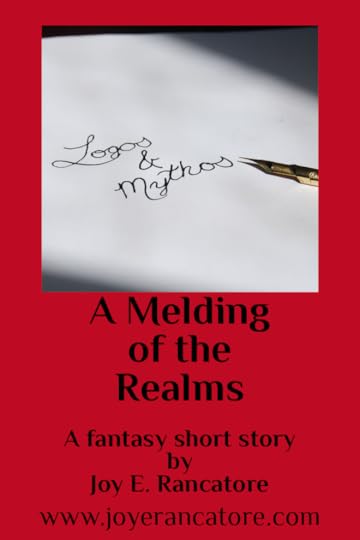
What do you think about this world of mine that I’m building? If you enjoyed this story, please head over to my site to read the entire Tales of the Faerie Shepherds series .
This month’s story flowed from the inspiration of a delightful monthly online writing prompt, #BlogBattle. As you will read on their site, “Blog Battle is a monthly writing prompt meant to inspire writers and entertain readers.” To read several outstanding stories inspired by February’s prompt, “Dusk,” head on over to the BlogBattlers site!
You may just find a new favorite author to follow!
For more detailed weekly updates on my writing process behind this short story as well as my other works, please subscribe to my newsletter!

The post A Melding of the Realms appeared first on Joy E. Rancatore.
March 13, 2019
Not Just Self-Published
More than once or twice, I’ve heard an author apologize, “I’m just self-published.” That phrase hurts my heart. Why? Because what I hear beneath their choice of words and tone is something I want them to hear:
“I wrote something straight from my heart that I believed in so much, I backed it with my time, energy and money so other readers could believe in it, too.”
While this has rested on my heart and mind for a while, two takeaways have surfaced. They go together, though, so please don’t read one without the other.
1. Wash that just right out with a shot of confidence.
Before I dive in here, please take extra note that I wrote confidence. I did not write pride or hubris or boasting.
Now that we’ve got that clear, you are just as much an author with your one book that you published as an author who’s been published countless times by one of the Big 5.
You plotted and outlined—or pantsed—your way to a first draft where you went beginning to end (or zigzaggy) until you had a completed story baby.
Then you revised, rewrote, edited, rewrote, got help and feedback and critiques and outside—hopefully professional—edits and rewrote again until your book shone as bright as any polished diamond.
Whatever your reason, you chose to put your money behind your dream and publish your own book. You’re kind of a rock star, my friend!
This leads us to my second takeaway that MUST accompany the first.
2. Chase it down with a slow drink of professionalism.
I’ve got to give you a note before we tumble down a cliff on this one, too. You may not have done this on your book—or your first five, depending on where you are in your journey. And, that’s OKAY. Reread that last sentence until it completely settles in your soul, because your commitment to fulfill your dream is what makes you the author I declared you to be in the first point.
Sure, there are still a few pockets of folks who look down long noses over horn-rimmed glasses at anyone not traditionally published, but they are few and far between and transitioning to the land of the dodo bird.
Chin up, writer friend, and let’s make ourselves better than we were yesterday! How do we do this? I’m so glad you asked!
You’ve got your shot of confidence warming your resolve, so now it’s time for some slow sipping. I have to add here that some folks sip slower than others and that is just fine.
Don’t compare your rate of progress to someone else’s. The only person you should ever compare yourself to is yesterday’s you.
Now that we’ve got that out of the way, let’s get on with this whole professionalism thing!
How to Be a More Professional Author
Outsource to the professionals …
… or become a pro yourself in: editing, formatting, cover design and marketing (both creation of materials and the marketing itself).
I’m not going to turn this into a soapbox post, but I will quickly explain what I wrote above.
Editing, designing, formatting and marketing must be handled professionally and thoroughly. You would be a rare breed, indeed, if you could handle them all on that level by yourself. So, for the sake of all that inspiring belief in your dream that we lauded earlier, … don’t try.
Up next, present yourself as the professional author you are. Step one is keeping that pesky just out of your introduction. I’ve made the next three steps into an acrostic for you. How about PRO?
Polite
I’d like to think these first two are no-brainers, but—alas! Wherever you go and whatever you do, specifically as it relates to your public profile online or in person as a professional author, be polite to everyone you meet—from the president of the board of a book festival to the stranger in line next to you at a book checkout.
As an additional piece of advice for your online endeavors, just stick to books and writing and reading and the occasional pet or food picture. Politics, pet peeves, soapboxes and rants of any kind have no place there. And, that’s all I’ve got to say about that. (Said in my best Forrest Gump voice.)
Respectful
Let’s take this a step further. I was in a local independent bookstore last year—trying to work up the courage to ask for their process and policies concerning local independent authors—when in walks a lady who put a pamphlet in the salesperson’s hand and proceeded to explain why she needed to put them out on display. You see, this woman’s friend—who was self-published—was holding an event—to sell his or her books, by the way … wait for it … at another business!
I was confused, too.
The saleslady was far nicer than I would have been as she explained how it didn’t make sense for them—a book STORE—to promote an event for books to be sold at ANOTHER business. This friend got quite indignant. I just shook my head. The saleslady shook her head. We had a laugh over it, and then I politely and respectfully asked for the store’s process for Indie Authors.
Apparently things like this happen often in our wonderful independent bookstores. One of the panels I attended last year at the Alabama Book Festival was led by bookstore owners. They talked about how many writers come in with books that are not edited— or well-written to begin with—or well-designed. They expect the bookstore to want them, no questions asked. Often, these books are also not appropriate for the audience of the store, and the author has no marketing plan or desire to help promote their book.
Don’t be that person.
Open & Organized
With these two word choices, let me be clear—I do not mean “say yes to everything” and I do not mean “you must be the most squared away person who’s always got every aspect of their lives together.” If that were the case, then I’d have to tap out right now!
Be open to opportunities. Often it’s when we least expect it that the best breaks come our way. The best way to be in a position to accept such chances is to simply be an involved member of your local literary community as well as the online literary community.
Not everyone is a planner user, but you’re going to need some sort of system if you’re going to start entertaining opportunities as they arise. And, remember, some of these may pop up a year or more in advance. You don’t want to agree to help with something only to have to back out because you forgot about another commitment. You’ll also want to be prepared with a business card or a pen for signing or a book kit with which to present a bookstore owner. Have your media kit ready so you can forward it in a couple clicks. That organization could be the difference between a place on a panel at a huge conference and missing out on selling the hundred books you could have if you had been ready to say yes.
I’m full of suggestions and advice for authors ready to drop just from their vocabulary, but I’ll close with this today. I prefer to introduce myself as an author or an Indie Author for a couple of reasons. First, I want to avoid any negative connotations some people may still have with the term self-published. I don’t want to give them a reason to automatically discount me over one word.
Second, this is my business—my career. I am serious about it and believe these titles best convey that focus and dedication.
So, to all my fellow Indie Author PROs, rock on!
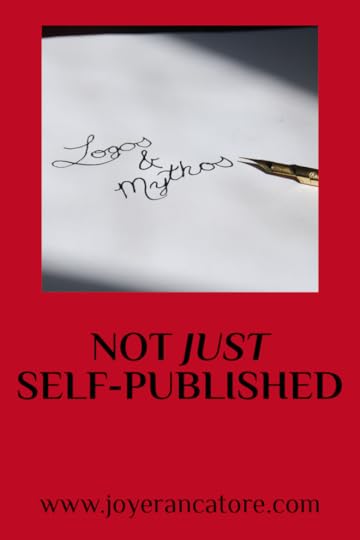
Readers, do you have any aversion to the term self-published? Is it something you’ve never given much thought to? Or, perhaps, do you seek out new Indie Authors in order to read their books? Who are some of your favorites and why?
Writers, have you ever used the word just in introducing yourself? Are you ready to break free from that word? If so, shoot me an email or leave me a comment. I want to hear all about it!

FollowFollowFollowFollowFollow
The post Not Just Self-Published appeared first on Joy E. Rancatore.
March 6, 2019
KINND Book Reviews: How Do I Write Them?
So far in this series, we’ve looked at why we should write book reviews, and I’ve shared with you my handy little acrostic for what a KINND book review is.
Now it’s time to get to the details of how this should look. I’m going into more depth on each word to explain how you can achieve this in your own reviews and then I’ll share with you my most recent book review, for which I used this technique!
KNOW The Story, The Genre & Your Preference
The Story
Reviews don’t necessarily have to begin with a summary of the book, but I find them helpful for a few main reasons. First, it provides another point of view for readers to know what they’re getting into. They can also be beneficial to the authors to see if the themes and central ideas or characters or events they intended really carry through clearly for their readers.
Second, a brief summary gives me a glimpse into what kind of reviewer you are and if I think I can put stock in your opinions. Now, please remember, a summary should be brief and should NOT include spoilers—unless you mark it as such. Goodreads and most book seller sites have a handy little checkbox for that. One click and no unsuspecting reader will stumble upon the whodunit in your summary unless they want to.
Third, it helps you think through what you read and identify some of the other details we’ll get to in just a moment.
The Genre
With all the subgenres and sub-subgenres out there, I don’t expect anyone really knows how to categorize some books these days. That being said, you need to know enough about the genre this book has been placed in to understand if it’s something you typically read and to know what’s expected (or not expected).
Your Preference
And, that leads to the fact that you’ve got to know what you like to read. Like I mentioned in the first part of this series, I applaud you for reading books outside of your comfort zone. You have to understand, though, that you may not enjoy that book. And, if not, your review and rating should be based on the book itself in relation to its genre and the expectations of that listing and not your personal preference.
IDENTIFY The Positives & Negatives with Specificity
Two-word reviews are helpful to no one.
Like I mentioned in the last post, you can definitely choose to leave a review to just the stars, especially if you’re a reader who loves to read and wants to help authors get more ratings but you don’t have a lot of time. But, if you want to get all of the other benefits of reviews for yourself and others, that’s where words come into play and they really must go deeper than two words.
[Quick note before I dive in here: you do NOT have to answer all of these questions! What jumps out at you will be different than what jumps out at me and will vary from book to book as well. These are simply to get you thinking.]
So, you hated a book. Why? Maybe what you didn’t like would be something I would enjoy.
You loved another book. Why? Share with me why you found joy in that particular book!
Get as specific as you can.
Was the storyline confusing? Was there way too much description for your preference? Could you see the setting and smell the jasmine through the pine trees?
Did you fall in love with the characters from their very first scene? Could you hear them speak to one another? Did they come to life for you—or could you not relate to them or empathize with them? Why do you think that is?
How did the dialogue work? Did it read like a natural conversation or was it forced? What about the story’s open and close? Did it grab your attention right away or did you have to push your way through? Was the ending satisfying or did it leave you feeling let down? Can you identify why for each of these things?
Those are the details that will help other readers make their choice. You may abhor descriptive writing, but I adore it. So, when you tell me what you hated and why, I may realize that book is right up my alley.
Your specificity can also help authors either take steps to improve or have a happy cry to see how their hard work positively affected someone.
I do have to add a quick sidenote here, though: not all authors read their reviews. For some, they prefer to focus on the joy of the writing without getting caught up in the emotional roller coaster that reviews often bring or they simply don’t have the time to read every one. So, just know that Janet Evanovich or Stephen King are probably not going to get your super personal message in the review you write.
NAME The Author, Publisher & Editor to Remember Humanity
This may sound weird, but I think it’s helpful to write the author’s name in your review. It helps you remember this book was written by a real, flesh-and-blood person. Someone who put in countless hours and energy and heart stands behind these words.
Beyond that, real people hold the roles of publisher, editor, designer, etc. Now, I don’t think you necessarily need to include their names (and you may not even notice their names when you read anyway), but just remembering the humanity behind the books helps you consider any criticisms through a different lens.
Two aspects that get criticized often in reviews are the editing (of lack thereof) and design of a book.
Editing
The other helpful part to keeping in mind the various roles behind the entire publishing process is to remember that the author is not always to blame for a lack of editing. On the flip side, it’s not always the editor either.
So, who is responsible? Well, it depends on many things.
I will be the first to bemoan the fact that careful editing has apparently gone the way of the dodo bird; however, I cannot tell you exactly why that is. I have some speculations that I won’t be sharing here and a few that I will.
My best guesses for traditional publishing companies are budget cuts and shortened production times. I have picked up books from some top publishing companies recently and found errors that make my skin crawl. Because I don’t know why those issues make it to the finished product, I can’t blame any one person.
Where I have the most experience is with Indie Authors. Editing in that case is a two-way street. The author may hire an outstanding editor, but the ultimate choice to accept or deny their changes rests with the author. Conversely, some authors either don’t see the need to hire an editor or don’t think they can afford one. In other cases, they just don’t get all the editing they really need. And, yes, there are “editors” who are not as qualified as they say.
Design
You may not be bothered by a few typos scattered through the manuscript, but a poorly designed cover or one that just doesn’t seem to fit the story within may bug you to no end. In that case, let me share a few behind-the-scenes details. Typically with traditionally published books, the author has absolutely no say in the cover (and sometimes even the title). For Indies, many of the same issues that apply to editing fit here as well. In addition to the cost or need issue and the unqualified designers, sometimes the author has an image in their mind that they just won’t let go of—whether it actually makes for a good cover design or not.
At the end of the day, you can’t know (unless you worked behind the scenes on a book) who’s really to blame for shoddy editing or design. For that reason, a review that calls out one person for inconsistencies in comma use is just silly. Point out your concerns in a positive and constructive way without pointing fingers and move on.
NOTE Observations & Remarks on Unusual or Uncommon Aspects
Did the author write a common story or theme but do it in a new way? Was there something unique about the setting of the book? And, did these unusual things work?
As you work through these questions and others that come to you, remember the key in the “Identify” step above: be specific. Get detailed. Give reasons. You may not always be able to do that because you just don’t know why, and that’s okay. But do your best to back up everything you say—both the positives and the negatives—with specific details.
DRIVE The Author to Keep Going & Other Readers to Pick It Up
If you reflected objectively on it and gave a KINND review, you will be able to encourage the author to do one of two things—improve or keep shining.
If the book just wasn’t your cup of tea but you’ve written a KINND review, you will be able to encourage other readers who will enjoy it to read it.
Why Did I Come Up With This?
Honestly, I devised this process for myself. I was frustrated with the pitiful—and often hateful—reviews I kept finding, and then I thought about my own reviews. I realized I’ve never been super consistent or helpful with my own book reviews. Right then and there, I decided I would do better. To do that, I needed a guide. I don’t know about you, but having a format I can follow really helps me.
What About the Stars?
Every online book review platform has you choose a certain number of stars for the book you read. I’ll be honest, this is one of the most subjective rating systems known to man. I know people who consider three stars great praise and five nearly unachievable; others bawl their eyes out over a 3-star review.
I’m afraid I’m not super helpful for you with this one. Most of my ratings stick within the 3-5 range. I’m fairly generous with five stars, I suppose. Unless I have a good reason for it, I won’t go too low.
Some readers I know assign their own guidelines to their rating system. Goodreads does have its own definitions for each:
1 Star: Did Not Like It
2 Stars: It Was OK
3 Stars: Liked It
4 Stars: Really Liked It
5 Stars: It Was Amazing
My Examples
Below, I’m sharing four versions of a KINND book review for Robin Hobb’s The Farseer: Assassin’s Apprentice. I decided to write multiple to show you that you don’t have to be wordy to write a helpful and KINND book review!
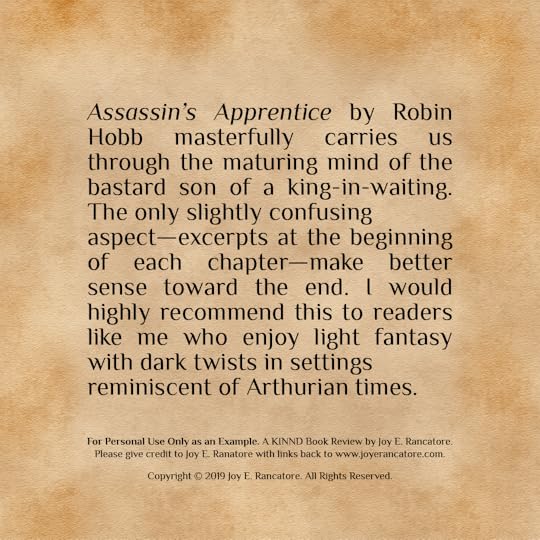
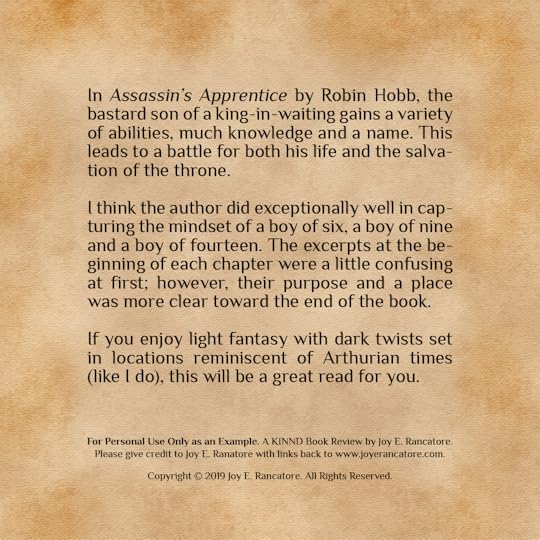
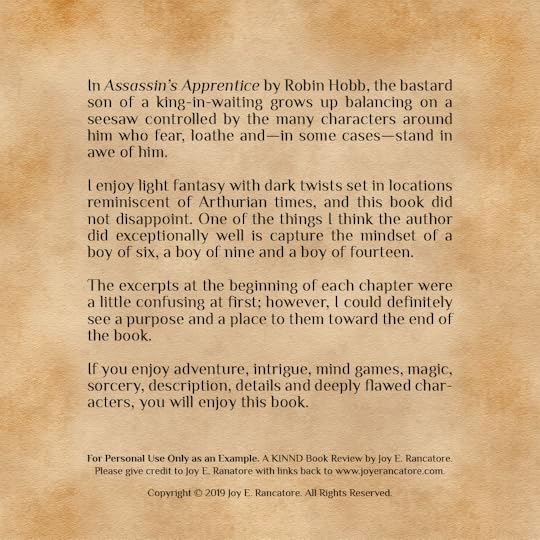
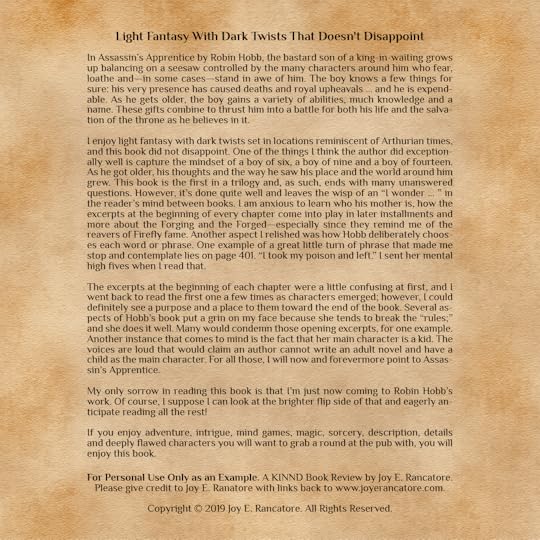
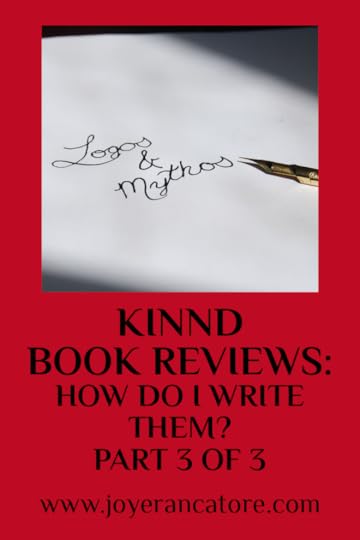
I’d love to hear your thoughts on book reviews and this little series I’ve written. Do you plan to start writing KINND book reviews? I would LOVE to read them! Drop some links in the comments below or send me an email. You can also follow me in all my social places and especially on Goodreads.
If you’d like a FREE printable PDF with a quick breakdown of How to Write a KINND Book Review, please subscribe to my weekly newsletter. You may unsubscribe at any time, though I hope you’ll stick around to be part of my Fellowship!

FollowFollowFollowFollowFollow
The post KINND Book Reviews: How Do I Write Them? appeared first on Joy E. Rancatore.
March 3, 2019
KINND Book Reviews: What Are They?
Perhaps I’ve convinced you that writing book reviews is worth your time. I hope so!
Over the past few months, I’ve experienced frustration with poorly written or unhelpful reviews, irritation with reviews whose ratings are based on personal preferences—from people who don’t like the kind of book they’re reviewing—and anger at scathing reviews that attack authors in personal ways rather than evaluating the book. So, to combat that, I’ve found myself urging reader friends to leave a “kind” review.
I knew what I meant by that, but realized it probably needed some explanation since it doesn’t just mean “be nice!” Great reviews must be honest, after all. When I sat down to work out a helpful acrostic, I added an “N” and came up with this outline for a KINND review.
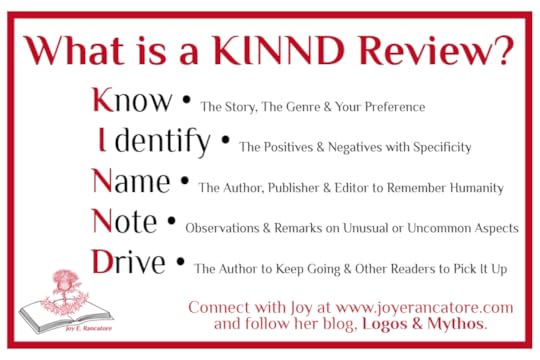
Know
First of all, you should know what you’re reading. What was this tale all about? What type of book—genre—is it? Is this a kind of book you typically read?
Identify
When you get into the meat of the review, you need to express the book’s positives and negatives with specificity. Two of the worst things you can do when writing a review is click the first star, write “It sucked” and post OR click the fifth star, write “Loved it” and post.
Name
This may sound weird, but I think it’s helpful to write the author’s name in your review. It helps you remember this book was written by a real, flesh-and-blood person. Someone who put in countless hours and energy and heart stands behind these words.
Beyond that, real people hold the roles of publisher, editor, designer, etc. Now, I don’t think you necessarily need to include their names (and you may not even notice their names when you read anyway), but just remembering the humanity behind the books helps you consider any criticisms through a different lens.
Note
This is a great place to offer some observations and remarks on unusual or uncommon aspects in the book. Dig deep and think through specific aspects of the story that you liked or didn’t like and why.
Drive
As you close out your review, whether it’s been two sentences or twenty, remember the why of writing it and drive the author to keep going and other readers to pick the book up.
So, what if you absolutely cannot find anything positive to say? Well, friend, unless you have no choice but to leave a review, a time-tested adage answers this best: “If you don’t have anything nice to say, don’t say anything at all.”
Before I close this post, I want to give you a quick rundown of what a book review should NOT be. It should NOT:
Undermine the importance of an honest review;
Nitpick about details that aren’t helpful for a reader trying to choose their next book;
Kick an author or attack his or her personal life;
Idealize what you think books should include or not include or the exact formula by which they should be written;
Negate an entire book based solely on your preferences;
Neglect the specifics in order to quickly bring an author down for your own personal vendetta; or
Disappoint potential readers by including spoilers or by failing to provide specifics with the intention of allowing them to determine if a book is for them or not.

What do you think about this little acrostic? Do you think it will be helpful as you write your own book reviews? What have been some of the most helpful details included in book reviews that you’ve appreciated? What was the least helpful review you ever read?
Please tune back in on Thursday for our third part in this series on KINND book reviews as I give some specifics on HOW to write them. If you’d like a free PDF to help you write your own reviews, please subscribe to my weekly newsletter. I’ll see you there!

The post KINND Book Reviews: What Are They? appeared first on Joy E. Rancatore.



